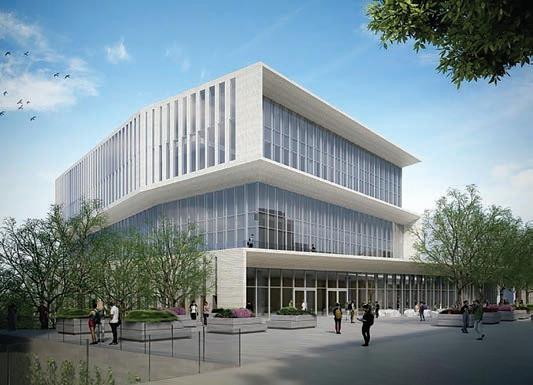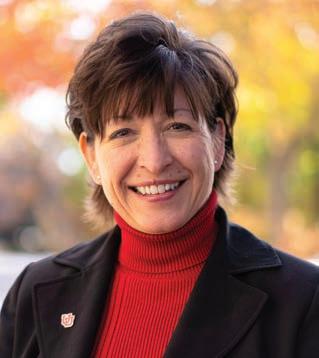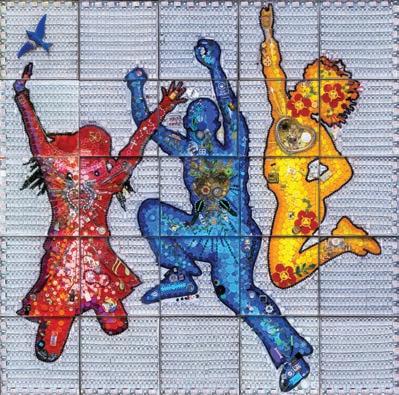
5 minute read
Groundbreaking Development
A new home for the Spencer Fox Eccles School of Medicine is the next evolution in providing top-tier care, education, and research
University of Utah Health is the only academic medical center in the Mountain West, providing high quality patient care for nearly 10 percent of the geographic area of the continental United States. The construction of the medical education building is expected to drive the most critical evolution in the medical school’s history and will be used across education, research, and clinical care.
New Provost Named
The U broke ground last fall on the new home for the Spencer Fox Eccles School of Medicine. The $185 million facility has been made possible, in part, by funds from a landmark gift of $110 million from the George S. and Dolores Doré Eccles Foundation and the Nora Eccles Treadwell Foundation. The gift provides support for not only the building but also medical education programs and cardiovascular research.
The 185,000-square-foot building will become the hub of the
U’s nationally recognized health sciences campus.
“The incredible impact of the University of Utah’s health sciences program in education, research, and care across the Intermountain West is a source of great pride for the entire state,” says Utah Governor Spencer J. Cox. “This new facility will make a major difference in our ability to address the growing need for top-tier doctors in the state, especially in our rural areas.”
“I have long believed that no state or region can become truly great without a world-class medical center at its nucleus,” says Spencer F. Eccles BS’56, namesake of the school and chairman and CEO of both the George S. and Dolores Doré Eccles Foundation and the Nora Eccles Treadwell Foundation. “We hope this seminal grant—the largest ever awarded by our foundations—will help ensure the university not only provides the highest quality medical education for the doctors who serve Utah and the entire Intermountain West, but also furthers the excellence of health care for all our citizens and impacts the future of medicine through its groundbreaking research.”
Picture
The U has a new provost and senior vice president for academic affairs. In this role, Mitzi M. Montoya is responsible for setting the academic vision and strategic focus of the U.

“I am honored and thrilled to join the outstanding faculty of the U and move to the beautiful state of Utah. The steady trajectory of the university is impressive, and I am inspired by President Randall’s bold vision for the future,” says Montoya. “I look forward to working together with the entire leadership team to build on the momentum and help the U achieve its goals.”
Montoya brings strong leadership skills to the position at the U, including experience gained as dean of the Anderson School of Management at The University of New Mexico; dean of the College of Business at Oregon State University; and vice president and university dean of entrepreneurship and innovation, as well as dean of the College of Technology & Innovation, at Arizona State University. Montoya is a professor of marketing and received her doctorate from Michigan State University.
Empty COVID-19 vaccine vials, clean medical waste, and other personal mementos make up the new art installation recently unveiled at University of Utah Hospital. The piece, titled Rise Up, was born from Project Art Heals Utah, which was created to commemorate experiences and losses related to the COVID-19 pandemic.
The work is a collaboration between U of U Health physician Emily Hagn MD’06 and artist Heidi Calega, with special thanks to U of U Health, the Spencer S. Eccles Health Sciences Library, and the Salt Lake County Health Department.

Montoya follows Martell Teasley, who had served as the U’s interim senior vice president for academic affairs since January 2022. He led the academic enterprise through a presidential transition and the continued unwinding of the COVID-19 pandemic.
“I welcome Dr. Montoya to Utah and look forward to supporting and working with her in the years ahead,” says Teasley. “We have much to accomplish to become a model public university, and I want to make sure that during this transition and over the longer-term horizon, we don’t miss a beat.”
Wayne County
Training Utah’s Rural Nurses
There’s not a typical day in rural nursing. “You never quite know what’s coming,” says Josie Moosman, a U College of Nursing student and nurse at the Wayne Community Health Center in Bicknell, Utah, population 330. In one shift, she may do a well-baby checkup, arrange a patient’s end-of-life care plan, cover ambulance rides, or prepare an emergency patient for a helicopter transfer. “It’s very dynamic,” she notes. “We really do work at the top of our licensure.”
Rural populations are significantly impacted by health disparity, experiencing higher rates of disease and disability and lower life expectancy than their urban counterparts. Registered nurses who work in rural communities play a paramount role in caring for these underserved individuals and families.
However, it’s not easy to recruit and retain rural RNs. There’s a knowledge and skill gap related to rural health care, and limited pathways for students to enter the field of rural nursing.
To address the growing health care needs of Utah’s rural populations, the U’s College of Nursing obtained a Nurse Education, Practice, Quality, and Retention (NEPQR) grant. NEPQR provides online training modules, scholarships, and travel funding for student nurses to gain experience in rural clinics like those of the Wayne Community Health Center. In turn, the center’s RNs receive training and resources.
“We want nurses to be prepared for rural nursing and want to work in rural settings,” says Brenda Luther MS’99 PhD’10, a professor of nursing at the U.
For her part, Moosman says, “It’s extremely rewarding to be a nurse in rural health care. You’re treating people you know and you love.” She is continuing her nursing education in the U’s Doctor of Nursing Practice Program—allowing her to provide even more community support as a nurse practitioner.
JACQUELINE SCHEIDER
Tayla Chiang
First-Generation College Student, Pre-Med
I fell in love with medicine at a young age. I’ve always had the desire to help people. In high school, I started looking for ways to get involved, like volunteering at Primary Children’s Hospital. One summer, I emailed a bunch of professors at the U and asked, “Can I do research in your lab?” Someone got back to me and said yes.
Then I found the PathMaker program at Huntsman Cancer Institute, where you get to live on campus, work in a research lab, and shadow doctors. I loved seeing how they made patients feel safe at a time when they’re so vulnerable.
The mentors I met were so supportive and made me believe I could pursue medicine. I knew I wanted to come to the U, but I couldn’t really afford to go to college if I didn’t get a scholarship. One of my mentors told me to apply for the Larry H. and Gail Miller Enrichment Scholarship, which covers tuition, housing, books, and fees. When I heard I received it, it felt like a dream. The scholarship has allowed me to focus on school instead of worrying about the cost of tuition. I’m able to get involved on campus and explore college life.
I’m really proud of being a first-generation college student. I love that I’m different compared to other people, because that’s what makes me, me. When I become a doctor, I really want to teach students and people of color. I would love to help the younger generation believe they can pursue medicine. I want to be that person who inspires other people.









